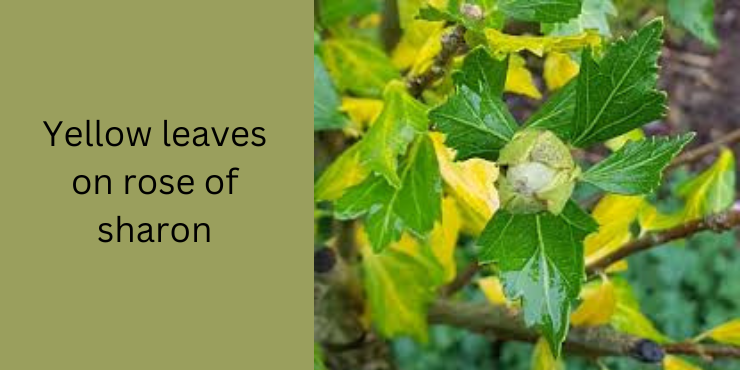Introduction:
The Rose of Sharon, scientifically known as Hibiscus syriacus, is a stunning flowering shrub that graces gardens with its vibrant blooms and lush foliage. However, the sight of yellow leaves on a Rose of Sharon can be disheartening for any gardener. Yellowing leaves are often an indicator of underlying issues that need attention. In this article, we will explore the various causes of yellow leaves on Rose of Sharon and discuss effective remedies to restore the plant’s health and vitality.
Yellow leaves on rose of Sharon

The presence of yellow leaves on a Rose of Sharon plant can be indicative of various underlying issues affecting its health. Yellowing leaves may result from a combination of environmental, cultural, or physiological factors. Here are some potential reasons for yellow leaves on a Rose of Sharon:
Environmental Factors:
One of the primary reasons for yellow leaves on Rose of Sharon is adverse environmental conditions. Factors such as excessive sunlight, inadequate water, poor soil quality, and extreme temperatures can stress the plant, leading to yellowing foliage.
- Sunlight: Rose of Sharon generally thrives in full sunlight, but prolonged exposure to intense sunlight, especially during scorching summer days, can lead to sunburn and yellowing of leaves. Consider providing partial shade during the hottest parts of the day.
- Watering: Insufficient or excessive watering can both contribute to yellowing leaves. Ensure that the soil is consistently moist but well-draining. Mulching can help retain moisture and regulate soil temperature.
- Soil Quality: Rose of Sharon prefers well-drained, nutrient-rich soil. Yellowing leaves may indicate poor soil quality or nutrient deficiencies. Regularly amend the soil with organic matter and provide a balanced fertilizer during the growing season.
Pest Infestations:
Pests can wreak havoc on the health of Rose of Sharon, leading to yellowing leaves. Aphids, spider mites, and scale insects are common culprits.
- Aphids: These tiny insects feed on the sap of the plant, causing yellowing and distortion of leaves. Use insecticidal soap or neem oil to control aphid infestations.
- Spider Mites: These microscopic pests suck the sap from the leaves, leading to stippling and yellowing. Increase humidity around the plant, regularly spray the foliage with water, and use insecticidal soap.
- Scale Insects: These pests attach themselves to the stems and leaves, draining the plant of its vital fluids. Use horticultural oil or insecticidal soap to control scale infestations.
Diseases:
Fungal infections and diseases can also contribute to yellow leaves on Rose of Sharon. Common diseases include powdery mildew and leaf spot.
- Powdery Mildew: This fungal infection appears as a white powdery substance on the leaves, leading to yellowing and distortion. Fungicides and proper air circulation can help manage powdery mildew.
- Leaf Spot: Dark spots with yellow halos characterize this fungal infection. Prune affected leaves, ensure proper spacing between plants for air circulation, and apply fungicides as needed.
Nutrient Deficiencies:
Yellow leaves may be a sign of nutrient deficiencies, particularly nitrogen, iron, or magnesium.
- Nitrogen Deficiency: Yellowing of older leaves while the veins remain green is a classic sign of nitrogen deficiency. Apply a nitrogen-rich fertilizer to address this issue.
- Iron Deficiency: Yellowing between the veins, known as interveinal chlorosis, indicates iron deficiency. Use iron chelate or iron sulfate to correct the deficiency.
- Magnesium Deficiency: Yellowing starts at the leaf margins and progresses inward. Apply magnesium-containing fertilizers to remedy magnesium deficiency.
To address yellowing leaves on a Rose of Sharon, a systematic approach involves examining the plant’s environment, soil conditions, and overall vitality. Adjusting watering routines, addressing nutrient deficiencies, and implementing pest control measures can contribute to the recovery of the plant, promoting the return of vibrant green foliage and robust flowering.
Conclusion:
The key to addressing yellow leaves on Rose of Sharon lies in identifying the underlying cause and implementing appropriate remedies. By paying attention to environmental factors, managing pest infestations, preventing diseases, and addressing nutrient deficiencies, gardeners can restore the health and beauty of their Rose of Sharon shrubs. Regular monitoring, proper care, and timely intervention will ensure a thriving and vibrant addition to any garden.


